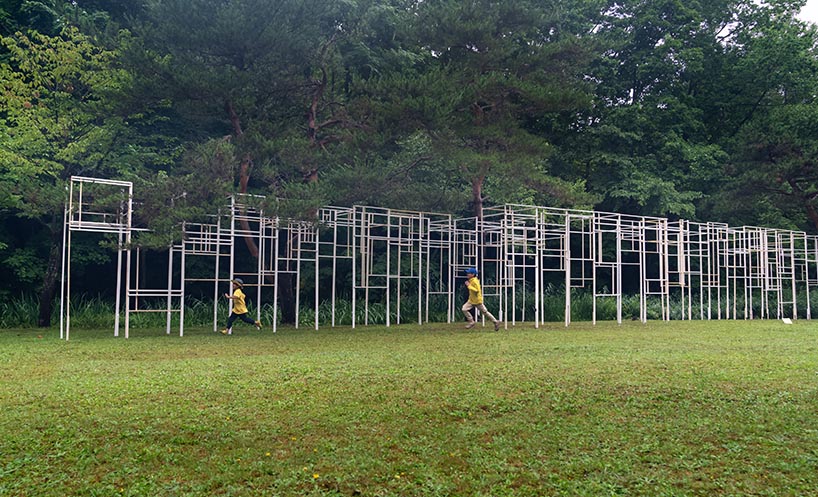This installation art piece named 107m3 Pavilion is interpreted as the “difference” between the breath each individual human takes versus the breath of a tree. The place where 107m3 Pavilion is situated was once a heavily wooded area in the west part of Hokkaido, which is the northernmost major island in Japanese Archipelago. The Ainu natives, known for their hunting culture, paid their sincere respects to the wooded area for its rich habitation of animals. The abundant deep forests succumbed to tree logging due to the increasing Sapporo-city’s population about a hundred years ago. Numerous amounts of trees were harvested to supply lumber for building houses in the area.
Your pavilion elaborates on the different pace of life between humans and nature. What did you discover combining two asymmetric rhythms?
Modern human beings is just a Moment compared with nature. Human beings is not at the center of the Earth.
While urban life has an increasingly stronger footprint on the natural environment, your pavilions and installations seem to suggest the possibility of a poetic that originates from rituals and natural cycles (water, air etc.). Do you think this is a futuristic way of design?
Thank you for your good and encouraging question. I am not sure this is a futuristic way of design yet. But I believe this way is one of the Role of art & design. I would like to visualize deep messages from nature. Also I am interested in expressing the connections with modern society.
What is your process, from design to realization?
[This one of a most difficult question for me]
-Time / If talking about -space size-, I try to calculate how many minutes people will spend preparing my work.
-Structure / On the other hand, -material size- is not calculable. When I need to decide a material, I check the durability of all the parts myself one by one.
-Contrast / For design work, I pay attention to make exhibition site and project work contrast. It might be not important for the concept. But regarding expression & explanation, I suppose that a contrast produces a positive effect.
Could you please suggest two essential book for you formation and explain why they were so important?
In Praise of Shadows – Junichiro Tanizaki, 1939
Nowadays we expect to understand the value every product. Also a quick internet research is essential before thinking already. In this book, Shadow & Light, Darkness, Invisible space etc hide a deep meanings and proper esthetics. These are not understandable shortly, but I think we should not forget this sense.
Architecture without Architects – Bernard Rudofsky, 1964
Rudofsky had focused as a pioneer to the vernacular cultures and rituals. This book told me that the important things are hiding and overlooked in the ordinary life.
What about your ongoing work? Can you give us some hints?
One of my projects has started to a preliminary phase. I am interested in and respect Ainu culture that is native indigenous in Hokkaido. The project will visualize their culture and aesthetic.
Also preliminary research is starting for a future project in Nordic countries. I would like to have experiences and think about possibilities in foreign countries. Landscape does not have a border line.














